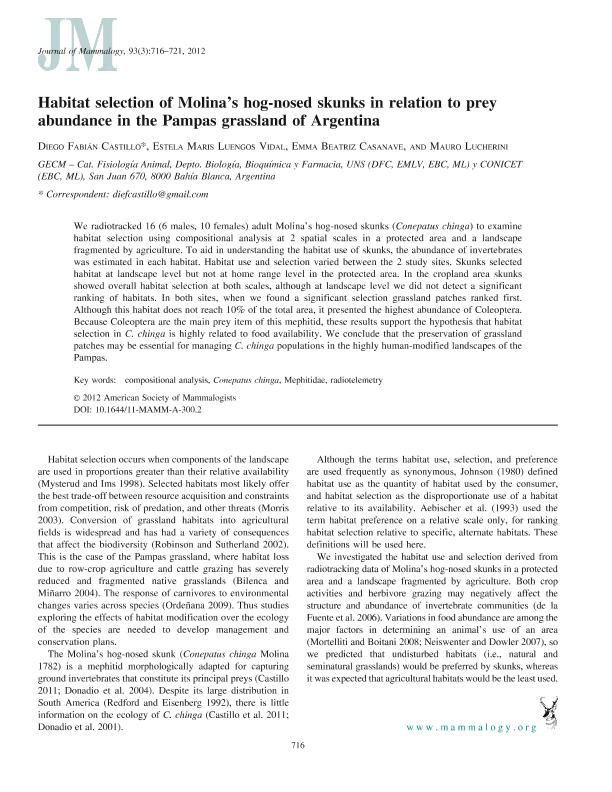Artículo
Habitat selection of Molina's hog-nosed skunks in relation to prey abundance in the Pampas grassland of Argentina
Fecha de publicación:
06/2012
Editorial:
Alliance Communications Group Division Allen Press
Revista:
Journal of Mammalogy
ISSN:
0022-2372
Idioma:
Inglés
Tipo de recurso:
Artículo publicado
Clasificación temática:
Resumen
We radiotracked 16 (6 males, 10 females) adult Molina's hog-nosed skunks (Conepatus chinga) to examine habitat selection using compositional analysis at 2 spatial scales in a protected area and a landscape fragmented by agriculture. To aid in understanding the habitat use of skunks, the abundance of invertebrates was estimated in each habitat. Habitat use and selection varied between the 2 study sites. Skunks selected habitat at landscape level but not at home range level in the protected area. In the cropland area skunks showed overall habitat selection at both scales, although at landscape level we did not detect a significant ranking of habitats. In both sites, when we found a significant selection grassland patches ranked first. Although this habitat does not reach 10 of the total area, it presented the highest abundance of Coleoptera. Because Coleoptera are the main prey item of this mephitid, these results support the hypothesis that habitat selection in C. chinga is highly related to food availability. We conclude that the preservation of grassland patches may be essential for managing C. chinga populations in the highly human-modified landscapes of the Pampas.
Palabras clave:
COMPOSITIONAL ANALYSIS
,
CONEPATUS CHINGA
,
MEPHITIDAE
,
RADIOTELEMETRY
Archivos asociados
Licencia
Identificadores
Colecciones
Articulos(CCT - BAHIA BLANCA)
Articulos de CTRO.CIENTIFICO TECNOL.CONICET - BAHIA BLANCA
Articulos de CTRO.CIENTIFICO TECNOL.CONICET - BAHIA BLANCA
Citación
Castillo, Diego Fabián; Luengos Vidal, Estela Maris; Casanave, Emma Beatriz; Lucherini, Mauro; Habitat selection of Molina's hog-nosed skunks in relation to prey abundance in the Pampas grassland of Argentina; Alliance Communications Group Division Allen Press; Journal of Mammalogy; 93; 3; 6-2012; 716-721
Compartir
Altmétricas




